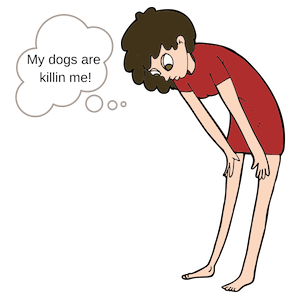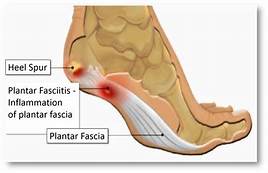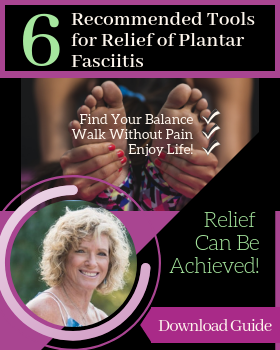EVERY STEP HURTS
I may as well have had a club at the end of my appendage. That’s what my foot felt like when my plantar fasciitis was in FULL bloom. My arch was nonexistent, flat as a board. Tight as a drum. No bend to that puppy! I pretty much flopped my foot with each step.
ON A SCALE OF 1-10, MY PAIN WAS AT 12!

Let’s back up this story a couple of months…
MY ‘PAINFUL’ STORY
We had just relocated back to the Bay Area. Picture 52,000 boxes (it seemed like that many) crammed into our tiny townhouse. If you’ve moved recently, you know what I’m talking about; unwrapping each piece, discarding packing paper, and finding a place for each prized possession. What was I thinking? I’m standing, unpacking box after box, in one spot (for the most part) for hours on end. STANDING IS THE ONE SINGLE ACTION THAT KILLED MY FOOT!
I tried stretching to no avail. I wore a brace at nighttime to keep my calf flexed, no luck. Someone told me of a sports chiropractor that did manual therapy.
I made the call, set the appointment and prayed I could handle what was next. Treatment was 15 minutes of an EXCRUCIATING pain having scar tissue rubbed out in the arch of my foot. On top of that, the next 15 minutes was all about my calf. I got the world’s best (or worst) ab workout reacting to the pain coming from my calf. I endured this treatment twice a week for six weeks. But I was still searching for the root cause of my pain. Concurrently I was also receiving alignment treatment– back, hips to knee to ankle to foot. The kinetic chain. It took three therapy sessions over a twelve week period to balance my right side and another three months of limited activity to let the nerves settle.
To encourage my body to stay in proper alignment and comfortable, here’s what helps me:
- stretching hip flexors regularly, both static and isometric1
- use of a brace to keep calf flexed and prevent toe point under covers
- after exercise, use a frozen water bottle to roll my foot to relieve any inflammation
- regular use of a roller or ball to smooth knots and tights spots; adductors are a problem area for me
- Massage as often as I can afford
- Ibuprofen, when necessary, to help stay ahead of any pain
- Various tools — rolling, stretching and strengthing devices
When I first noticed my feet having issues ten years ago, I sought the help of a Podiatrist. After a walking analysis, orthotics were prescribed and fitted. I did get relief from a weak/fallen arch in my right foot. I was playing many hours of tennis on hard courts back then. However, orthotics did not prevent me from developing plantar fasciitis.
If you know me, you know I LOVE to play tennis. I missed seven months of playing. After feeling better, I started back to the gym to regain strength lost after a long lay-off. After a couple of months in the gym, I finally made it back on the court. Yay!!

After going through this experience, I continually talk to at least two people per week that suffer from plantar fasciitis, some more debilitating than others. I tell them my story and results and hope that they too find relief as well.
WHAT IS PLANTAR FASCIITIS?
 Your foot has thick, fibrous bands of tissue (“fascia”) reaching from your heel to your toes. These tissues support the muscles and arch of the foot. When overly stretched, tiny tears can occur on their surface. The damage causes pain and inflammation when walking.2
Your foot has thick, fibrous bands of tissue (“fascia”) reaching from your heel to your toes. These tissues support the muscles and arch of the foot. When overly stretched, tiny tears can occur on their surface. The damage causes pain and inflammation when walking.2
Doctors once thought bony growths called heel spurs created this type of pain. Now they believe that heel spurs are the result — not the cause — of pain from plantar fasciitis.
PLANTAR FASCIITIS SYMPTOMS
- Bottom of your foot pain — at the front or center of the heel bone
- Morning pain during the first steps after rolling out of bed (“first-step-pain”)
- Pain after long periods of standing or standing after sitting/resting for a while
- After exercise; stiffness and pain
WHAT PUTS YOU AT RISK FOR PLANTAR FASCIITIS?
- Wearing worn-out shoes or shoes with thin soles
- Having flat feet or a very high arch
- Wearing high-heeled shoes often
- Having tight Achilles tendons
- Having an unusual walk or foot position
RELIEF IS IN SIGHT
Medication – Nonsteroidal anti-inflammatory drugs to alleviate pain.
Steroid Injections – When NSAIDs don’t help, steroid injection in the most painful part of the plantar fascia. It will ease your pain for ~1 month but will keep the inflammation down longer than that.
Physical Therapy – If medication, rest and ice are giving you relief, your doctor may recommend physical therapy. You’ll learn proper stretches and strengthening techniques for the plantar fascia, Achilles tendon, and lower leg muscles. The use of massage, contrast baths or ultrasonography is long-term healing therapies.
In most severe cases where the above treatments are not helping, your doctor may recommend the following:
Shock-Wave Therapy – This “shocks” the plantar fascia with sound waves to stimulate blood flow in the foot and help the tissue heal. It also stops the pain by “stunning” the nerves.
As a LAST resort Surgery – The operation takes your plantar fascia off of the heel bone.
AT THE END OF THE DAY, we want the pain to STOP.
My recommendation is to keep searching and find YOUR root cause. I suffered for many, many months. I learned by trial and error what helped me. Three years and I am pain-free. However, I constantly watch for symptoms. I’m diligent about wearing proper footwear, stretching before, and moreover after exercise. I roll my foot on a soft roller or frozen water bottle every day.
1I found a great reference for stretching hip flexors. See UnlockYourHipFlexors.com to download your copy.
2Web Med, Understanding Plantar Fasciitis Basics









Facebook Comments